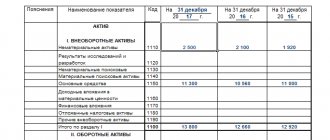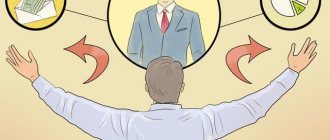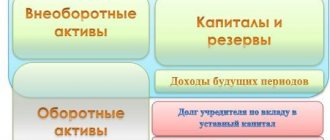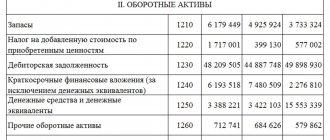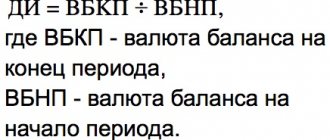Other current assets are those company resources that were not included in the main lines of the assets section of the balance sheet. They appear on line 1260.
Other current assets include:
- Proceeds from the sale of property for which the buyer has not yet acquired title. That is, the transaction has been completed, but the documentation has not been completed properly. During such operations, an accountant usually makes a note in the 1C software product.
- VAT accrued but temporarily not taken into account. The conditions under which revenue will be recognized later are specified in PBU 9/99.
- The amount of expended material assets of the enterprise and identified shortages for which posting is temporarily impossible.
- Advance and excise assets, as well as VAT on them, the reimbursement of which has been postponed for a short period.
- Accrued revenue not presented for payment.
- The amount of excise assets that were acquired with subsequent sale.
IMPORTANT! Sources of other current assets can be both own funds and those raised or received by borrowing from third parties.
What are other current assets?
Other current assets (OCA) are minor items on a company's balance sheet that are combined into one account because they are not important enough to warrant a separate list . These assets are not cash or cash equivalents and represent a limited source of liquidity for the company.
Take our proprietary course on choosing stocks on the stock market → training course
Reports may contain references that indicate what is included in other categories of current assets for the benefit of investors who want to gain more information about the firm. Typically, the amount of such assets is small and may not have a significant impact on the overall financial position of the company.
POA is a category of assets that a firm owns, benefits from, or uses to generate income. It can always be converted into cash within one business cycle. They are referred to as "other" because they are unusual or insignificant, unlike typical current asset items.
POA are indicated in line 1260 of the balance sheet and are part of current assets.
Important! For the term 1260, the amounts of PAP are reflected that meet the conditions:
- circulation period up to one year or cycle;
- data and information about these funds is not significant when analyzing the financial condition of the company;
- the data cannot be reflected on other lines of current assets;
- the amounts are very small;
- amounts are reflected at the end of the year in the balance sheet.
Important! When assessing the financial condition, an analysis of the turnover of working capital is carried out for each line, including in relation to POA. The growth of the turnover rate has a positive trend and indicates an increase in the efficiency of their use in the company. With a decrease in the turnover rate, we can talk about a decrease in the efficiency of using POA,
Line 1250 “Cash and cash equivalents”
Line 1250 indicates information about the company’s money - both in rubles and in foreign currency. So, on line 1250 of the balance sheet they reflect:
- money in the company's cash desk, as well as the cost of monetary documents (for example, postage stamps, paid travel tickets, vouchers, etc.);
- money in bank accounts
- money in foreign currency held in foreign currency accounts in banks;
- other funds, for example money held in special bank accounts, transfers in transit, etc.
Funds in deposit accounts opened for the purpose of generating income are not shown in line 1250. Depending on the term of the deposit, they are reflected either on line 1170 (long-term) or on line 1250 (short-term) of the balance sheet.
The cost of funds in foreign currency is converted into rubles at the official exchange rate of the Bank of Russia as of the reporting date. To fill out this line, use data on the organization’s cash balances reflected in bank statements and the cash book.
The organization's cash equivalents are also entered in line 1250 of the balance sheet. These are short-term (for a period of no more than 3 months) and highly liquid investments that are not subject to the risk of changes in value, which can be converted into a predetermined amount of money. For example, this is a cash equivalent - this is a bank deposit on demand.
Thus, in line 1250 the debit balance is entered for accounts 50 “Cash”, 51 “Cash accounts”, 52 “Currency accounts”, etc.
Composition of other current assets
The following categories may be included in the PAA:
- sales revenue that was not recognized;
- VAT on the above revenue;
- defective products or goods and materials;
- if the registration process is not completed, the right to property;
- shortage of goods and materials in the absence of a culprit;
- shares that were purchased for the purpose of immediate resale.
Important! When including amounts in the POA, the debit balance of such accounts as: 45, 46, 62,68,69,81,94 is used.
Reserves
Regulated by PBU 5/01 “Accounting for inventories”
Inventories are a very voluminous item that includes the following main assets:
- raw materials and supplies used in the production of products, as well as intended for sale or use for the management needs of the organization;
- fuel,
- semi-finished products
- workwear,
- finished products;
- goods;
- animals being raised and fattened.
Essence and understanding
The company's assets are reflected in the balance sheet as fixed assets and current assets (current assets). Fixed assets are typically long-term tangible assets, such as buildings, computer equipment, and land, that a firm owns and uses in its operations to generate income. They have a useful life of more than a year and are not liquid.
Current assets, on the other hand, are all of a company's active assets that are expected to be readily and easily sold, consumed, used, or depleted in the normal course of the firm's business operations. They can be easily sold for cash, usually within one year, and are taken into account when calculating the firm's ability to pay short-term obligations.
There are revolving funds that are unusual, non-standard. They do not fall into any of the specific categories listed above. These assets are grouped together under the "other" category. They will be reflected as other current assets (OCA) on the balance sheet.
Examples of POA:
- advances paid to employees or suppliers;
- part of the property that is being prepared for sale;
- limited funds or investments;
- issuance of life insurance policies.
What do they include
For detailed information on the state of other current assets, it is assumed that there is a specially designated line 12605 “Deferred expenses”.
This line reflects income from the sale of property, the right to ownership of which has not yet been registered in the name of the buyer. To clarify the situation, an accompanying note or a note in the form of an additional line with a transcript is allowed as an attachment.
Also, line 12605 takes into account the value added tax, which was accrued on the amount of revenue received, but cannot be temporarily taken into account due to the following circumstances regulated in PBU 9/99. Conditions for revenue recognition that must be met simultaneously:
- The right to receive revenue for an organization is legally secured and has a legal basis, i.e. it arose when concluding the relevant agreement or in another way.
- The amount of money received is determinable.
- When there is a guarantee that from specific actions, the enterprise will receive an increase in economic benefits. For example, when a firm has received payment for an asset or its receipt is certain.
- Ownership of certain products has been transferred from the organization to the buyer, customer, and also if the service has been provided in full and accepted.
- The expenses that the company has made or plans to make have a cost determination.
If at least one condition is not met, then the cash and other assets that were transferred to the company will not be taken into account in the revenue column, but will be taken into account in the balance sheet in the accounts receivable group.
However, there are exceptions:
- Lease or provision for temporary operation of any asset owned by the company.
- Providing intellectual property products – registered patents – for remuneration for temporary use. They can be for inventions, samples of industrial equipment and other types.
- Taking part in the authorized capital of other enterprises.
To recognize the revenue of such organizations, it is necessary to simultaneously fulfill only the first three items from the list.
- The amount of damage caused due to property damage or shortages, the culprit of which has not yet been identified or a decision has not been made to write them off as expenses for the production process or sales expenses.
- VAT and excise taxes refundable in the near future.
- The price determined by the contract, which has been calculated but not yet issued.
- The amount of shares that were purchased from other companies for further resale.
Advantages and disadvantages of formation
Advantages of forming other current assets:
- by creating this category, full accounting of all short-term assets that are individually insignificant and non-standard occurs;
- within one category, the accounting process is simplified.
Disadvantages of forming a group:
- lack of clarity, since some companies do not form such assets;
- any asset position that has outgrown the one-year period or one business cycle must be rolled over into any long-term asset class. However, there are cases where such assets are ignored and erroneously retained under other current assets, which is an important deficiency. In this case, working capital requirements increase.
- Sometimes an increase in one of the assets is offset by a decrease in another asset as part of other current assets. In such a scenario, there are unlikely to be significant differences in the aggregate and therefore the change in individual assets is ignored.
Calculation examples
Let's look at a few examples to understand this category of assets.
Example No. 1.
Let's consider an example of including an asset in other current assets.
Initial data:
- In company X, an audit of the availability of property was carried out, as a result of which a shortage in the amount of 16 thousand rubles was revealed;
- On March 24, an advance payment for products was received in the amount of 236 tr, including VAT;
- On March 29, the products were shipped under the contract. The cost of sales is estimated at 354 thousand rubles, including VAT;
- the cost of sales was 180 tr.
Reflection in accounting
| No. | Operation | Dt | CT | Amount, t.r. |
| 1 | Write-off of the cost of shortage | 91 | 41 | 16 |
| 2 | Receiving an advance payment | 51 | 62Av | 236 |
| 3 | VAT calculation | 76 | 68 | 36 |
| 4 | Reflection of product shipment | 45 | 41 | 180 |
| 5 | VAT calculation | 76 | 68 | 54 |
Line 1260 reflects the following amounts:
16+36+54 = 106 tr.
Example No. 2. Example of calculating the POA.
The initial data is shown in the table below.
| Article | 2017, t.r. | 2018, t.r. |
| Reserves | 47899 | 55477 |
| Accounts receivable | 23459 | 28444 |
| Cash | 7855 | 9411 |
| Total current assets | 85090 | 103073 |
Calculation of the value of other current assets:
- 2017: 85090-47899-23459-7855 = 5877 TR;
- 2018: 103073-55477-28444-9411 = 9741 tr.
The calculated data will allow us to conclude that the value of the LOA increased by 3864 tr.
Features of the funds
When discussing other current assets, information may be included in the footnotes and notes to the company's accounts. Explanations may be necessary, for example, when there is a noticeable change in other current assets from one period to the next.
Other current assets are expected to exit this category during the year or be transferred to another form. As such, their value can vary greatly from year to year, depending on the company's financial health and how it spends its money.
Important! It is important to determine how significant these assets are because they may distort the firm's liquidity.
When funds in other current assets increase to a significant level, the account becomes important enough to be included in the main current accounts on the balance sheet.
It is recommended to conduct a special analysis of the asset turnover of the company's balance sheet according to turnover ratios in order to understand the dynamics of the growth of the company's funds.
The result of such an analysis may be an increase in the indicators that are included in line 1260. This will mean that the organization uses funds rationally and its activities are characterized by stability.
Line 1240 “Financial investments (except ...)”
In line 1240, reflect data on short-term financial investments. Here we are talking about assets with a circulation or maturity period of no more than 12 months. For example, these are loans issued for a period of less than a year, bills or bonds with a maturity of no more than 12 months. Data on long-term investments are indicated in line 1170 of the first section of the balance sheet.
In line 1240 enter the debit balance of account 58 “Financial investments” (in terms of short-term investments). If a company creates a reserve for reducing the cost of financial investments, then the indicator in line 1240 of the balance sheet is reflected minus contributions to this reserve. That is, when filling out line 1240, the credit balance of account 59 “Provisions for impairment of financial investments” is subtracted from the debit balance of account 58.
Information about interest-free loans is not indicated in line 1240. Such loans are not financial investments. Therefore, their amount is taken into account as part of accounts receivable on line 1230 of the balance sheet.
And further. Line 1240 does not reflect information about cash equivalents. Their amount is given in line 1250 of the balance sheet.
FAQ
Question No. 1. What are the main characteristics of other current assets?
Answer. Main characteristics:
- collection of information on all means that are used in different periods of time: year, business cycle;
- the cost is written off on finished products within one year;
- are present in the balance sheet in line 1260.
Question No. 2. There was a sharp increase in the value of other current assets on the balance sheet. They accounted for 0.5% of the total balance at the beginning of the year and grew to 85% in the structure of current assets. Is this good or bad and what might be the reason?
Answer. Since line 1260 reflects information about assets that are not reflected in other lines of the second section of the balance sheet. This is usually the debit balance of accounts 45,46, 62,68,69,76,81,94.
The following values can be taken into account here:
- material assets that are missing or have been damaged. Inventory and materials for which no decision has been made to write them off as production costs;
- the amount of VAT accrued on advances and prepayments. Which is separately indicated on account 62 or 76;
- the amount of excise taxes that will be subject to deductions in the future;
- amounts of taxes that were excessively collected or paid;
- the amount of VAT on shipment of products for which revenue is not recognized in accounting;
- shares (own) or shares that were purchased from shareholders for subsequent resale;
- other assets with very little value.
A sharp increase trend is good in a situation where the company’s liquidity after all the changes remains at the same level or improves. Otherwise, the trend is unfavorable.
Line 1260
The second section of the balance sheet includes important reporting lines that are filled out accurately and in line. The economic resources of the company that are not subject to reflection in the main lines of the report of the 2nd section are entered in line 1260. If the company considers the balance sheet indicators to be insignificant, then they are reflected in “Other current assets”. This list may include:
- Unfinished stages of work;
- VAT accrued upon shipment of goods;
- Amounts of unwritten shortfalls;
- The cost of damaged but not written off material assets;
- Amounts of excise taxes that are subject to deductions in the future;
- Accrued but not presented for payment revenue, etc.
Important ! Before filling out line 1260, read the regulatory documents: pp. 1, 2, 17, 23 PBU 2/2008; para. 2 paragraph 7 of the letter of the Ministry of Finance of Russia dated November 12, 1996 N 96 “On the procedure for reflecting in accounting certain transactions related to value added tax and excise taxes,” paragraphs. 2 p. 1 art. 167 Tax Code of the Russian Federation, clause 34 PBU 4/99; Art. 200-201 Tax Code of the Russian Federation; clause 1 clause 1 art. 167 Tax Code of the Russian Federation, clause 12 PBU 9/99); para. 2 clause 9 art. 165, para. 21 clause 7 art. 198 Tax Code of the Russian Federation, para. 2 letters from the Ministry of Finance of Russia dated May 27, 2003 N 16-00-14/177.
If the amounts for reporting are insignificant, then when filling out the declaration it is possible to enter a single figure with explanations for the balance sheet; this corresponds to paragraph. 3 clause 11 PBU 4/99 information on certain types of assets. “Other current assets” of the balance sheet cannot reflect current assets, information about which is material.
